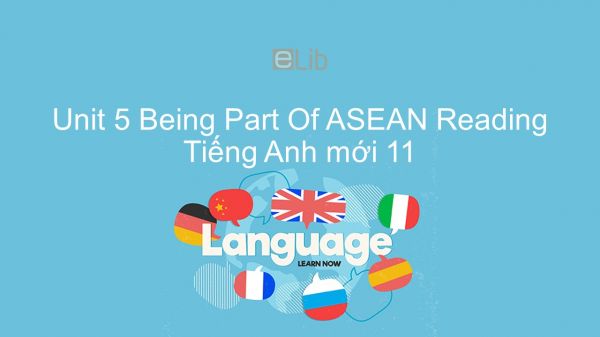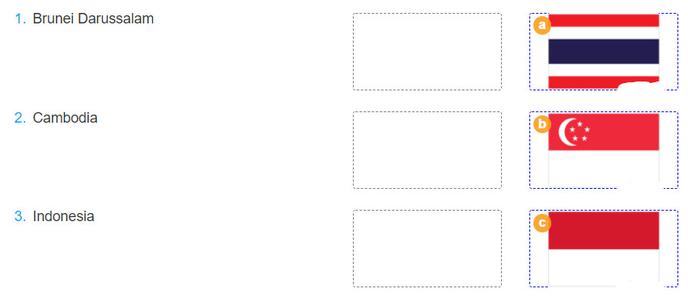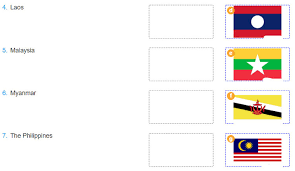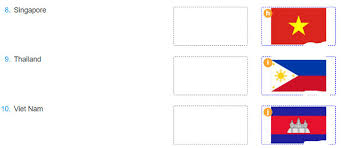Unit 5 lớp 11: Being Part Of ASEAN - Reading
Nhằm giúp các em nâng cao kĩ năng đọc hiểu, phần Reading dưới đây cung cấp cho các dạng bài tập khác nhau, giúp các em hiểu về chủ đề "Trở thành một phần của ASEAN". Mời các em cùng tham khảo!
Mục lục nội dung

1. Task 1 Unit 5 lớp 11 Reading
Match the countries with their national flags. Check the answers with a partner. (Hãy ghép tên các quốc gia với quốc kỳ của họ. Kiểm tra câu trả lời với bạn bên cạnh.)



Guide to answer
1. Brunei Darussalam - f
2. Cambodia - j
3. Indonesia - c
4. Laos - d
5. Malaysia - g
6. Myanmar - e
7. The Philippines - i
8. Singapore - b
9. Thailand - a
10. Viet Nam - h
2. Task 2 Unit 5 lớp 11 Reading
The following text has five paragraphs. Read it first, and then match the headings (1-5) with the paragraphs (A-E). (Bài đọc dưới đây có 5 đoạn. Đầu tiên em hãy đọc nó. Sau đó hãy ghép tiêu đề đúng (1-5) cho mỗi đoạn (A-E).)
1. Cultural and sports acticities (Các hoạt động văn hóa thể thao)
2. Aims and motto (Mục đích và phương châm)
3. Charter (Hiến chương)
4. Area, population and economies (Diện tích, dân số và nền kinh tế)
5. History and membership (Lịch sử và số thành viên)
A. ASEAN stands for the Association of Southeast Asian Nations, which was formed on August 8th 1967, in Bangkok, Thailand by Indonesia, Malaysia, the Philippines, Singapore and Thailand. Brunei Darussalam became the sixth member in 1984, right after its independence. In 1995, Viet Nam became the seventh member. Laos and Myanmar joined the bloc in 1997, and Cambodia joined two years later.
B. The bloc has a land area of 4.46 million km? and a population of about 600 million people. Its sea area is about three times larger than its land area. ASEAN would rank as the eighth largest economy in the world if it were a single country. Indonesia, Thailand, Malaysia, Singapore, the Philippines and Viet Nam are called the six majors. These countries are the six largest economies in the region.
C. ASEAN aims at promoting economic growth, social progress and cultural development. At the same time, it focuses on protecting regional peace and stability, and providing opportunities for its member states to discuss differences peacefully. The bloc’s motto is: ‘One Vision, One Identity, One Community’.
D. The ASEAN Charter came into force on 15 December 2008. It is the Constitution of ASEAN and the ten member states must act in accordance with it. After entering into force on December 15th 2008, the Charter has become a legal agreement among the ten ASEAN member states. Its main principles include respect for the member states’ independence and non-interference in their internal affairs.
E. ASEAN organises different projects and activities to integrate its members. These include educational awards, and various cultural and sports activities. Examples of these are the Singapore-sponsored ASEAN Scholarships, the Southeast Asian Games, the ASEAN Para Games, the ASEAN Schools Games and the ASEAN Football Championship.
Guide to answer
1.E 2.C 3.D 4.B 5.A
Tạm dịch
A. ASEAN viết tắt của cụm từ Hiệp Hội các nước Đông Nam Á (tiếng Anh là: The Association of Southeast Asian Nations) được thành lập vào ngày 8/8/1967 tại Băng Cốc, Thái Lan do các nước In-đô-nê-xi-a. Ma-lai-xi-a, Phi-líp-pin, Sing-ga-po và Thái Lan. Bru-nây Đa-ru-xa-lem trở thành thành viên thứ sáu năm 1984 ngay sau khi giành được độc lập. Năm 1995 Việt Nam trở thành thành viên thứ bảy. Lào và Mi-an-ma gia nhập khối năm 1997, và sau đó hai năm là Cam-pu-chia.
B. Khối ASEAN có diện tích đất là 4,46 triệu km2 và dân số vào khoảng 600 triệu người. Diện tích biển khoảng gấp 3 lần diện tích đất. Khối ASEAN xếp hạng là nền kinh tế lớn nhất thứ tám nếu nó được xem là một quốc gia. In-đô-nê-xi-a, Thái Lan, Ma-lai-xi-a, Sing-ga-po, Phi-líp-pin và Việt Nam được gọi là 6 quốc gia chính yếu. Những quốc gia này là 6 quốc gia có nền kinh tế mạnh nhất khu vực.
C. ASEAN có mục tiêu thúc đẩy sự phái triển kinh tế, tiến bộ xã hội và phát triển văn hóa. Cùng một lúc, khối này tập trung vào việc bảo vệ hòa bình và sự ổn định trong khu vực, đem lại những cơ hội cho các quốc gia thành viên nhằm thảo luận về sự khác nhau giữa các nước một cách hòa bình. Phương châm của khối là: "Một Tầm Nhìn, Một Bản sắc, Một Cộng Đồng"
D. Hiến Chương ASEAN có hiệu lực vào ngày 15 tháng 12 năm 2008. Đó là Hiến Pháp ASEAN và 10 quốc gia thành viên phải hành động phù hợp với hiến pháp đó. Sau khi có hiệu lực, Hiến Pháp đã trở thành sự thỏa thuận mang tính pháp lý cúa 10 quốc gia thành viên. Những nguyên tắc cơ bản của nó bao gồm sự tôn trọng đối với nền độc lập của các quốc gia thành viên và không có sự can thiệp vào công việc nội bộ của nhau.
E. ASEAN đã tổ chức nhiều dự án và các hoạt động để hội nhập các thành viên lại. Những hoạt động này bao gồm các giải thưởng giáo dục và nhiều hoạt động thể thao, văn hóa khác nữa. Những ví dụ của các hoạt động này là Học bổng du học ASEAN do Sing-ga-po tài trợ, Đại Hội Thể Thao Đông Nam Á, Đại Hội Thể Thao Người Khuyết Tật Đông Nam Á, Đại Hội Thể Thao Học Sinh Đông Nam Á và Giải Vô Địch Bóng Đá Đông Nam Á.
3. Task 3 Unit 5 lớp 11 Reading
Find the words or expressions in the text that have the following meanings. Write them in the correct space. (Tìm từ / cụm từ trong bài đọc có nghĩa dưới đây. Hãy viết chúng vào đúng ô.)

Guide to answer
1. the ASEAN Charter
2. non-interference
3. motto
4. respect
Tạm dịch
1. Hiến pháp ASEAN - Hiến chương ASEAN
2. chính sách không tham gia vào tranh chấp của các nước khác - không can thiệp
3. một câu hoặc cụm từ ngắn dùng để diễn tả một nguyên tắc, mục đích, hoặc lý tưởng của một người hoặc một tổ chức - phương châm
4. một hành động cho thấy chấp nhận, xem xét hoặc đánh giá đúng đắn - tôn trọng
4. Task 4 Unit 5 lớp 11 Reading
Read the text again and answer the questions. (Hãy đọc lại bài đọc và trả lời câu hỏi)
1. Which were the first five members of ASEAN? (Năm thành viên đầu tiên của ASEAN là những nước nào?)
2. When did the other states join the bloc? (Các quốc gia khác đã tham gia khối này khi nào?)
3. How big is ASEAN? (ASEAN lớn như thế nào?)
4. What are the six majors? (Sáu nước trọng yếu là những nước nào?)
5. What is ASEAN's motto? (Phương châm của ASEAN là gì?)
6. What are the main principles of the ASEAN Charter? (Các nguyên tắc chính của Hiến chương ASEAN là gì?)
7. How does the bloc integrate its state members? (Khối này kết nối các quốc gia thành viên bằng cách nào?)
Guide to answer
1. They were Indonesia, Malaysia, the Philippines, Singapore and Thailand. (Đó là Indonesia, Malaysia, Philippines, Singapore và Thái Lan.)
2. Brunei became the sixth member in 1984 and Viet Nam became the seventh member in 1995. Laos and Myanmar joined the bloc in 1997 and Cambodia joined two years later. (Brunei trở thành thành viên thứ 6 vào năm 1984 còn Việt Nam trở thành thành viên thứ 7 vào năm 1995. Lào và Myanmar gia nhập khối này vào năm 1997 còn Campuchia gia nhập hai năm sau đó.)
3. It has a land area of 4.46 million km2 and a population of about 600 million people. (ASEAN would rank as the eighth largest economny in the world if it were a single country.) (Khối này có diện tích đất liền là 4,46 triệu km2 và dân số vào khoảng 600 triệu người. (ASEAN sẽ được xếp hạng là nền kinh tế lớn thứ 8 thế giới nếu khối này là một quốc gia.)
4. They are Indonesia, Thailand, Malaysia, Singapore, the Philippines, and Viet Nam. (Đó là các nước Indonesia, Thái Lan, Malaysia, Singapore, Philipines và Việt Nam.)
5. It is 'One Vision, One Identity, One Community'. (Đó là 'Một Tầm nhìn, Một Bản sắc, Một Cộng đồng')
6. They are respect for the member states' independence and non-interference in their internal affairs. (Đó là tôn trọng nền độc lập của các nước thành viên và không can thiệp vào công việc nội bộ của các quốc gia này.)
7. It organises different projects and activities, including educational awards, and various cultural and sports activities. (Khối này tổ chức các dự án và hoạt động khác nhau, bao gồm các giải thưởng giáo dục, và nhiều hoạt động thể thao, văn hóa.)
5. Task 5 Unit 5 lớp 11 Reading
Work in groups of five. Each student in the group focuses on one paragraph and tries to remember as many details ds possible. Then close your book and quiz each other to see how much you have remembered. (Làm việc theo nhóm 5 người. Mỗi em trong nhóm tập trung vào một đoạn và cố gắng nhớ càng nhiều chi tiết càng tốt. Sau đó hãy gấp sách lại rồi đố nhau xem thử các em đã nhớ được bao nhiêu.)
Guide to answer
1. Which countries joined the bloc in 1997? (Các quốc gia nào gia nhập khối này vào năm 1997?)
2. What are the six majors? (Sáu nước trọng yếu là những nước nào?)
3. Which were the first five members of ASEAN? (Năm thành viên đầu tiên của ASEAN là những nước nào?)
4. What does ASEAN stand for? (ASEAN là viết tắt của những từ gì?)
5. Can you name some examples of the projects and activites that ASEAN organise? (Bạn có thể kể tên một vài dự án và hoạt động do ASEAN tổ chức không?)3. When was the bloc formed? (Khối này được thành lập khi nào?)
6. When did Viet Nam join ASEAN? (Việt Nam gia nhập ASEAN khi nào?)
7. How big is ASEAN? (ASEAN lớn như thế nào?)
8. What is ASEAN's motto? (Phương châm của ASEAN là gì?)
9. What are the main principles of the ASEAN Charter? (Các nguyên tắc chính của Hiến Chương ASEAN là gì?)
10. When did the ASEAN Charter come into force? (Hiến chương ASEAN bắt đầu có hiệu lực khi nào?)
6. Practice Task 1
Read the following passage and mark the letter A, B, C, or D to indicate the correct answer to each of the questions.
When Malaysia takes the ASEAN chair next year, it will face a huge challenge. Too few of us know enough about this grouping we call the Association of Southeast Asian Nations. We do not know what it means to be a part of ASEAN and why it is important to us. At the same time, pressure is mounting to reinvent ASEAN to make it more people-centric and less government-centric. The Heat speaks to Global Movement of Moderates CEO Saifuddin Abdullah on why ASEAN should mean more to us than just acronyms.
ASEAN people do not feel like they are a part of the community of Southeast Asian nations. This statement, backed up by survey findings, is pretty bizarre, and extremely hurtful too, considering that ASEAN is 47 years old today. "Interview 10 persons on the street and you would perhaps get only one of them who knows about ASEAN,” says Datuk Saifuddin Abdullah. This CEO of Global Movement of Moderates (GMM) is not running down ASEAN; he's confronting the truth as it impacts the project he has been entrusted with. Here's more, in 2012, the ASEAN Secretariat conducted a survey that showed only 34% of Malaysians had heard of the ASEAN community. This compares with 96% of Laotians. Malaysia chairs ASEAN next year, and GMM is a member of the national steering committee organising the ASEAN People's Forum (APF), a platform designed to bridge the gap between governments and civil society. Never heard of it? You're forgiven.
The APF actually started off life in the 1990s, except it was called the ASEAN People's Assembly (APA). It was held back to back with the ASEAN Summit, which is held twice a year. The APA is the forum where 10 leaders of government engage with 10 leaders of civil society in a half-hour meeting. "It was going well until one year when the chairman decided not to hold the APA, so it was discontinued until 2005 when Malaysia took the chairmanship of ASEAN again and founded the ASEAN People's Forum (APF)," Saifuddin explains. In a perfect world, forums such as the APF or its predecessor APA would have worked perfectly to bridge the gap between government and civil society.
However, as Saifuddin points out, Civil Society Organisations (CSOs) often do not see eye to eye with their governments. For instance this year, Myanmar is chair of ASEAN and in the APF, three member nations - including Malaysia - decided not to recognise the CSO leaders chosen as representatives so the APF did not take place. “This is where the GMM wants to play a role in ensuring that this situation does not arise again," Saifuddin says.
Question 1: According to the passage, in 1990s, APF was called ____.
A. ASEAN People's Assembly
B. ASEAN People's Forum
C. Civil Society Organisations
D. Global Movement of Moderates
Question 2: The word “acronyms” in paragraph 1 probably means ____.
A. abbreviations B. antonyms C. enlargements D. synonyms
Question 3: The phrase "backed up" in paragraph 2 has similar meaning to ____.
A. concluded B. introduced C. proved D. Supported
Question 4: According to the passage, Datuk Saifuddin Abdullah was CEO of ____.
A. APA B. APF C. CSOs D. GMM
Question 5: Which of the following statements is NOT true about the APF according to the passage?
A. APF consists of 20 leaders. B. APF is held every two years.
C. APF is reorganised in 2005. D. APF lasts for 30 minutes.
Question 6: The phrase "bridge the gap" in paragraph 3 is closest in meaning to ____.
A. avoid the conflict B. break down the wall
C. build a strong relation D. narrow the difference
Question 7: Which of the following statements is TRUE according to the passage?
A. Discontinuing APF led to conflict between government and civil society.
B. Laotians show more interest in politics than Malaysians.
C. The APA was held twice a year until 2005.
D. CSOs do not always agree with their governments.
Question 8: Which of the following would serve as the best title for the passage?
A. How important was the ASEAN People's Forum?
B. Who is going to be the ASEAN chair next year?
C. What does it mean to be a part of ASEAN?
D. Why do GMM play an important role in ASEAN?
7. Practice Task 2
Read the following passage and mark the letter A, B, C, or D on your answer sheet to indicate the correct answer to each of the questions.
Cooperation is the common endeavor of two or more people to perform a task or reach a jointly cherished goal. Like competition and conflict, there are different forms of cooperation, based on group organization and attitudes.
In the first form, known as primary cooperation, group and individual fuse. The group contains nearly all of each individual’s life. The rewards of the group’s work are shared with each member. There is an interlocking identity of individual, group and task performed. Means and goals become one, for cooperation itself is valued.
While primary cooperation is most often characteristic of preliterate societies, secondary cooperation is characteristic of many modem societies. In secondary cooperation, individuals devote only part of their lives to the group. Cooperation itself is not a value. Most members of the group feel loyalty, but the welfare of the group is not the first consideration. Members perform tasks so that they can separately enjoy the fruits of their cooperation in the form of salary prestige, or power. Business offices and professional athletic teams are examples of secondary cooperation.
In the third type called tertiary cooperation or accommodation, latent conflict underlies the shared work. The attitudes of the cooperating parties are purely opportunistic: the organization is loose and fragile. Accommodation involves common means to achieve antagonistic goals: it breaks down when the common means cease to aid each party in reaching its goals. This is not, strictly speaking cooperation at all, and hence the somewhat contradictory term antagonistic cooperation is sometimes used for this relationship.
Question 1: What is the author’s main purpose in the first paragraph of to passage?
A. To urge readers to cooperate more often
B. To offer a brief definition of cooperation
C. To explain how cooperation differs from competition and conflict
D. To show the importance of group organization and attitudes
Question 2: The word “cherished” in paragraph 1 is closest in meaning to _______
A. defined B. agreed on C. prized D. set up
Question 3: Which of the following statements about primary cooperation is supported by information in the passage?
A. It is usually the first stage of cooperation achieved by a group of individuals attempting to cooperate
B. It is most commonly seen among people who have not yet developed reading and writing skills
C. It is an ideal that can never be achieved
D. It was confined to prehistoric times
Question 4: According to the passage, why do people join groups that practice secondary cooperation?
A. To experience the satisfaction of cooperation
B. To associate with people who have similar backgrounds
C. To get rewards for themselves
D. To defeat a common enemy
Question 5: Which of the following is an example of the third form of cooperation as it is defined in the fourth paragraph?
A. Students form a study group so that all of them can improve their grades
B. Members of a farming community share work and the food that they grow
C. Two rival political parties temporarily work together to defeat a third party
D. A new business attempts to take customers away from an established company
Để nâng cao kĩ năng đọc hiểu về chủ đề "Being Part Of ASEAN", mời các em đến với phần luyện tập trắc nghiệm Unit 5 Reading Tiếng Anh 11 mới sau đây.
9. Conclusion
Kết thúc bài học, các em cần làm bài tập đầy đủ và luyện tập đọc hiểu, trả lời câu hỏi; đồng thời ghi nhớ các từ vựng:
- charter: hiến chương
- motto: phương châm
- non-interference: không can thiệp
- respect: tôn trọng
Tham khảo thêm
- doc Unit 5 lớp 11: Being Part Of ASEAN - Getting Started
- doc Unit 5 lớp 11: Being Part Of ASEAN - Language
- doc Unit 5 lớp 11: Being Part Of ASEAN - Speaking
- doc Unit 5 lớp 11: Being Part Of ASEAN - Listening
- doc Unit 5 lớp 11: Being Part Of ASEAN - Writing
- doc Unit 5 lớp 11: Being Part Of ASEAN - Communication and Culture
- doc Unit 5 lớp 11: Being Part Of ASEAN - Looking Back
- doc Unit 5 lớp 11: Being Part Of ASEAN - Project



